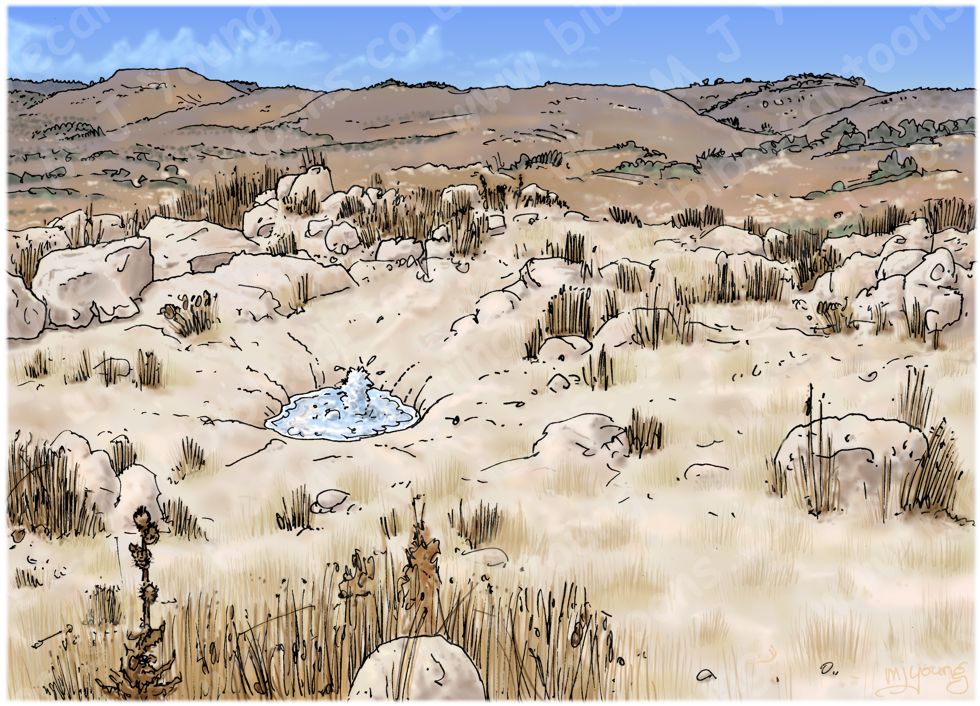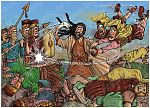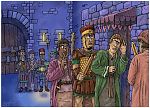Bible Cartoon: Judges 15 - Samson’s revenge - Scene 08 - En Hakkore spring
Click on Add to cart button below shopping cart.
Purchased Bible Cartoons do not have watermarks. Links to Cartoons provided on email once purchase is completed.Bible Book: Judges
Bible Book Code: 0701501701
Scene no: 8 of 8
Bible Reference & Cartoon Description
Judges 15:17-20 (ANIV)
17 When he [Samson] finished speaking, he threw away the jaw-bone; and the place was called Ramath Lehi. [1]
18 Because he was very thirsty, he cried out to the Lord, “You have given your servant this great victory. Must I now die of thirst and fall into the hands of the uncircumcised?” 19 Then God opened up the hollow place in Lehi, and water came out of it. When Samson drank, his strength returned and he revived. So the spring was called En Hakkore, [2] and it is still there in Lehi.
20 Samson led [3] Israel for twenty years in the days of the Philistines.
[1]
Ramath Lehi means jaw-bone hill.
[2]
En Hakkore means caller’s spring.
[3]
Tradionally, judged.
DRAWING NOTES:
TIME OF DAY:
The Bible doesn’t specify the time of day. Since this scene directly follows the previous one, the time is late morning.
LIGHTING NOTES:
There is sunlight used in this scene, coming from above & slightly to the left, casting short shadows to the right of the figure & objects.
CHARACTERS PRESENT:
Samson, kneeling.
RESEARCH/ADDITIONAL NOTES:
This scene shows Samson exhausted after his combat with the Philistines, kneeling down in the limestone landscape of Ramath Lehi (see note below for the possible location of this spring) [1].
Here’s the scene without the figure of Samson.

Background of Judges 15 – Samson’s revenge – Scene 08 – En Hakkore spring
Click on the colour bar below to view/buy this Background:
Background of Judges 15 – Samson’s revenge – Scene 08 – En Hakkore spring
As the Bible verses above state, Samson was pleading, or crying out to the Lord God for a drink of water after he killed 1000 Philistine men. As verse 19 explains, “God opened up the hollow place in Lehi, and water came out of it.” You can see the water spring starting to fill the depression in the limestone rocks behind Samson in my picture. Because the place was hollow it was capable of holding water. The “hollow place” is an English translation of the word mak̠tēš, which literally means “mortar,” i.e. a basin. The place where Samson’s strength was restored was called En Hakkore (“spring of the caller”) which was still in existence when the book of Judges was written.
Notice that verse 20 seems to be a summary of Samson’s leadership (judging) over Israel at this point, & is also noted in chp 16:31. The 20 years (about 1069-1049 B.C.) referred to would cover Samson’s adult life until his death in Gaza (see chp 16:30-31).
I found some photographs of Ramath Lehi on the internet, and recognized that the area has an underlying limestone geology. I decided to make all the plants, grasses and thistles (see left foreground) look brown and parched, to echo Samson’s one condition at this point in the narrative.
[1]
Part of a paper on The Location of Biblical Lehi, En-hakkore, and Ramath-lehi
“Shall I Die of Thirst?” – The Location of Biblical Lehi, En-hakkore, and Ramath-lehi
Chris McKinny, Texas A&M University-Corpus Christi
“…Lehi appears to have been a regional term that can be broadly localized to the area
between the eastern Shephelah and the hills west of Bethlehem, and narrowly
localized to the upper section of the Valley of Rephaim south of modern Jerusalem.”
[Source: Page 64 of https://hul.ariel.ac.il/wp/archaeology-and-text/wp-content/uploads/sites/139/2019/03/ArchiTxt_Vol2-2_Chris-McKinny.pdf]





